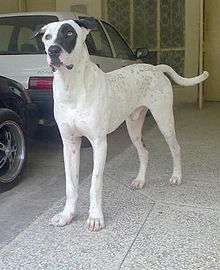Bully Kutta
 11 months old male | |||||||||||||||||||||||||||||||||||
| Other names |
Sindhi Mastiff Bully | ||||||||||||||||||||||||||||||||||
|---|---|---|---|---|---|---|---|---|---|---|---|---|---|---|---|---|---|---|---|---|---|---|---|---|---|---|---|---|---|---|---|---|---|---|---|
| |||||||||||||||||||||||||||||||||||
| Dog (Canis lupus familiaris) | |||||||||||||||||||||||||||||||||||
The Bully Kutta or Bully[1] or Indian Alangu Mastiff.[2] is a descendant of the extinct Alaunt that originated from the Sindh and Punjab regions of present-day Pakistan, where they are the most common guard-dog. The word Bully derives from the word bohli meaning heavily wrinkled in Hindi/Punjabi, while the word Kutta means dog in South-Asian languages.
Appearance
The Bully Kutta is predominantly white in color, however fawn, brindle, brown, black and various bicolors are also common. Bully Kutta can also be red nosed/yellow eyed but these are rare. Generally, a Bully Kutta stands 30"-33" tall. Usually they have large heads, strong bone structure, and loose, and stretchy skin.
Temperament
A Bully Kutta's temperament ranges in variety. Training them and introducing them to family early on in puppyhood is recommended. It is a very smart dog breed and it can be easily trained. They are loyal and protective of its master, their family, and their master's belongings.
Dog fighting
Because of this breed's aggression, it is commonly used in Pakistan for dog fighting.
See also
References
- ↑ Manish, Sai (11 Aug 2012). "Never mind the dog. Beware the owners.". Tehelka Magazine 9 (32). Retrieved 7 August 2012.
- ↑ "Bully Kutta". PetsWorld. Retrieved January 22, 2015.
| Wikimedia Commons has media related to Bully Kutta. |
| ||||||||||||